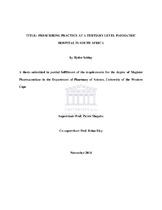| dc.description.abstract | The objectives of the present study were to describe the type and frequency of prescribing errors and error frequency, to determine the error frequency for different drug classes, to identify potential drug interactions and drug-disease interactions to point out off-label prescribing and to evaluate risk factors of prescribing errors. Methods: This prospective cross sectional study was conducted over a period of 6 months from July 2012 to December 2012 in 2 specialist wards and 2 general medical wards at Red Cross War Memorial Children’s Hospital in Cape Town in South Africa. Only prescriptions generated by doctors in the above mentioned wards were assessed. Convenience sampling was used to select 200 prescription charts for analysis. Information relating to prescribing error, potential drug interaction, potential drug-disease interactions, off-label prescribing and potential risk factors of prescribing error were entered into excel spreadsheet and analysed using STATA versions 11&12. The mass of the patients was converted into weight-for-age z-score (WAZ) using WHO 2006 child growth standards. Univariate analysis and multiple logistic regression were used to identify risk factors of prescribing errors. Results: Of the 200 children on whom prescribing information was analysed, 40 (20%) were severely underweight and a further 25(12.5%) were moderately underweight. A total of 1402 prescribing errors were documented in 1282 drug items prescribed, a rate of 1.09 errors per drug item prescribed. Incomplete prescription information was the most common type of prescribing error, present in 65.6% of all drug items prescribed. The error frequency was high for all drug classes ranging from 57.9% of all respiratory drug items prescribed to 86.4% of all gastro intestinal system drug items prescribed. The number of potential drug-drug interactions was low i.e. 20 potential pharmacodynamics and 49 potential pharmacokinetic drug interactions were identified. The number of potential drug-disease interactions was also low i.e. 39 or 0.03% per drug item prescribed. Furthermore 57 off-label prescribing incidences were recorded. Senior doctors posed a significant risk factor for prescribing errors, an OR 1.95, 95% CI 1.46 – 2.61. Conversely, prescriptions written up in the general wards compared to the specialty wards (an OR 0.65. 95% CI 0.47-0.90) and prescribing during weekends compared to weekdays (an OR 0.71, 95% CI 0.53-0.96) were associated with lower prescribing error risk. Conclusion: This study provided valuable information about prescribing practices in children at RCWMCH. There is a need to improve prescribers’ practice at RCWMCH considering the type of errors observed viz. missing information, use of wrong drug name, abbreviations, legibility concerns and lack of clarity of the prescriptions, among others. Based on this study results further intervention studies are recommended to investigate the level of medical student’s training w.r.t prescribing practice. | en_US |

